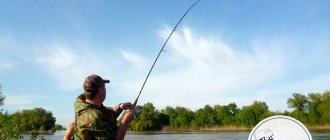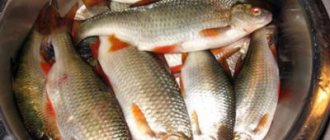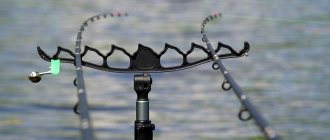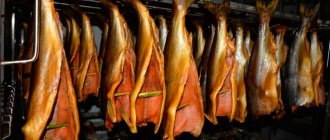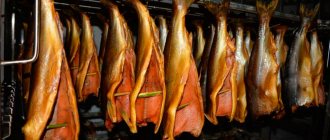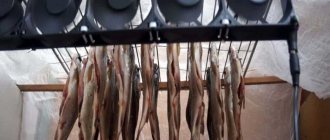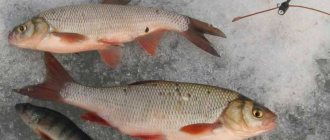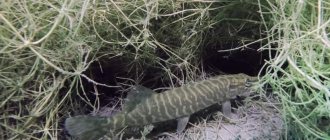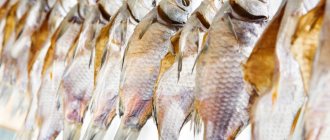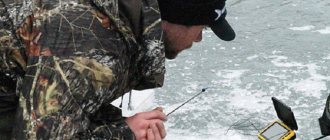Feeding peaceful fish
Feeding in the warm season
A pond in the garden is good.
It’s much more pleasant to look at a body of water waiting for a splash than to look at a predictable and stable lawn.
It’s just pointless to wait for a splash or a bite, or for children who will beg to feed the fish if there are none. And for fish to be playful, healthy, and strong, they need vitamins and energy to live - so they need to be fed sometimes, usually no more than 2-3 times a week.
In a reservoir, if it is not only dug and filled, there is a food supply, for example, aquatic plants, mosquito larvae, worms, various insects, zooplankton and phytoplankton. But in order for the fish to grow faster and to more often admire the colorful variegation of ornamental fish, KOI carps, and comets, you need to feed them.
It is better to feed the fish at the same time, in the same place. They will soon get used to your routine.
Feeding colored fish is a whole different story. They are so beautiful in their brightness. You approach the pond, and they greet you: they swim to the surface and eagerly await their portion.
Feeding fish requires attention. The main rule is not to overfeed - make sure that the fish eat the food quickly. Everything should be eaten within 5 minutes; If the allotted time has expired and there is still food left, the fish will overeat. Uneaten food will deteriorate, rot and provoke the proliferation of pathogenic bacteria, as well as the remains of floating food will attract birds and promote the growth of algae, which will cause the pond to bloom. This is why it is important to ensure that all food is eaten on time.
It is better to underfeed than to overfeed.
When not to feed
- When the water temperature is below 10 °C, since the metabolic rate is reduced, digestion slows down, the activity of the fish also decreases...
- After stress. For example, after transportation and landing in your pond. Wait a few days and then please.
Beneficial and healthy fish breeds in terms of nutrition
There is no bad without good. Likewise, there are benefits and benefits from fish in a pond.
- Fish tench, rudd and eel very actively eat frogs and their eggs;
- The fish paddlefish, silver carp and bighead carp filter microalgae from the water and grow from it;
- The grass carp fish is an excellent vegetation eater;
- The loach fish willingly eats the larvae of mosquitoes;
- In the warm season, the bream fish stirs up the silt and releases it from hydrogen sulfide, which in winter, under frozen ice, is very dangerous;
- And large fish will spread loud rumors about your pond to your neighbors!
Sale of compound feed
We offer only foreign-made food; we use this food ourselves. There is floating food on sale (for ornamental fish), sinking food for sturgeon and sinking food for everyone else. You can purchase food of different diameter fractions - both for fry and adults. Our food does not leave an oil film on the surface of the water, which prevents the fish from breathing.
- Sinking food can be bought in bags, bag weight: 25 kg, made in Germany or Denmark.
- Floating food can be purchased in bags.
- If there are very few fish in your pond, we suggest buying food packaged in small plastic sealed jars.
Where and how to buy fish feed
Food in bags (by pre-order), in plastic containers, both sinking and floating, can be bought in the Istra district, Dedovsk, 2nd Truda street, 3a.
To visit our base store, call us in advance to coordinate your arrival.
We work every day around the clock except Sunday .
Delivery is available by our driver throughout Moscow and the region. Calculation of kilometers from Dedovsk.
There should be a map here, if it is not there, refresh the page.
Subscribe to Alex FX news!
And we will immediately send you a brochure on how to feed the fish , where and how much. And when to stop feeding her...
In order to feed fish correctly, you must follow three main rules:
- Favorable conditions of maintenance;
- Proper feeding of pond fish;
- Prevention of diseases.
These are the three corners of the base of the pyramid of a healthy life! If even one rule is not followed, the entire pyramid will collapse.
Feeding is one of the three fundamental factors for the healthy and prosperous life of fish in a pond. Feeding determines how the fish will grow, its health, the presence of offspring and the quality of water in the reservoir.
Proper feeding of pond fish means compliance with standards and the use of balanced feed.
The feeding rate depends on the water temperature, the weight and age of the fish and the calorie content of the feed.
Since fish are cold-blooded animals, their metabolism is inextricably linked with the ambient temperature, i.e. water. When the temperature rises, metabolism increases, and when it decreases, on the contrary, it decreases.
Based on this, there are several rules:
- Feeding pood fish after winter should begin when the water temperature rises to 8-10 degrees Celsius.
- The feeding period for fish in the pond is spring-summer-autumn.
- You should not feed the fish in winter!
The water temperature under the ice is 4 degrees Celsius. At this temperature, the metabolic rate of the fish slows down as much as possible. The fish goes into suspended animation (complete or partial). The body is nourished using previously accumulated nutrients.
Keeping carp in winter
In winter, the nature of the basic physiological processes in carp radically changes, for example, feeding stops, the fish falls into a state close to hibernation. Low temperature has a great influence on fish (including carp), which has attracted the attention of a number of researchers, and this issue has turned out to be extremely complex: there are discrepancies and conflicting opinions regarding many factors.
The main thing that interests fish farmers and is of paramount practical importance is the winter hardiness of fish and the factors on which it depends. Of the cultivated breeds, the scaly carp, the mirror carp with scattered scales, and the frame carp survive winter better than others. Next, the age of the fish matters. Most of the yearlings die in winter; sometimes their departure is complete. Two-year-olds turn out to be much more stable.
The fatness and weight of the fish play a big role. It is not without reason that more than a hundred years ago it was pointed out that it is very important to raise large fingerlings - this largely guarantees its survival in the winter.
Rice. 1. Wintering ponds
For successful wintering, it is important to feed carp fingerlings well in the warm season, especially at the end of summer (August - September), since during this period reserve nutrients are created in the fish’s body. Young of the year tolerate winter better if their weight reaches 25-30 grams.
The sanitary condition of the pond and the health of the fish have a strong impact on the outcome of wintering: sick, parasite-ridden fish, as well as fish that have been injured and generally injured, do not withstand the winter well.
The conditions in which wintering takes place are also important. Smooth, stable weather without severe frosts, and equally without sharply occurring strong thaws, has a beneficial effect on the survival of fish; in such a winter, the gas regime in the wintering pond is also more stable and favorable.
The condition of primary importance is the oxygen content in the water. In winter, the fish's need for oxygen is less, and carp survive with an amount of oxygen of about 3 cubic centimeters per liter of water. The most favorable oxygen saturation of water is when its content is 4-5 cubic centimeters per liter of water. A high concentration of carbon dioxide in the water of a wintering pond is also unacceptable. It should be no more than 20-25 cubic centimeters per liter of water. Hydrogen sulfide is very harmful, even in small quantities. Iron oxides are also harmful. To prevent their accumulation, it is necessary to aerate the water. The water of wintering ponds should have a slightly alkaline reaction. Pollution of wintering ponds with wastewater is completely unacceptable.
Read also: Why should you drink oats?
Rice. 2. Ice holes on the wintering pond
The composition and quantity of incoming water during the winter must be checked regularly (at least three times a month), determining its gas regime and monitoring whether its taste, color change, or whether a fatty film or foam appears on it. All this indicates water spoilage. To monitor its condition, holes are made in the ice. You need to monitor the condition of the ice holes, preventing them from freezing, clearing them of snow, and chipping away the ice. To prevent the ice holes from being blocked by ice, they are covered with straw mats.
The water temperature in the wintering area is measured every day. It is also necessary to have instruments for determining oxygen, carbon dioxide and iron,
The water in wintering ponds must be running. However, it is not necessary to create a strong flow; Moreover, it is undesirable. Strong flow disturbs the fish; it has to move, overcome the current, and this leads to exhaustion. Typically, in wintering ponds, complete water exchange is completed within 12 days. And under favorable conditions, you can reduce the flow until you change the water within 20 or even 24 days.
We were just talking about wintering ponds. But in a number of southern regions of the country, fish are left to spend the winter in nursery or feeding ponds, unless they freeze to the very bottom.
Wintering in summer ponds even has some advantages. First of all, the fish here are not deprived of food and can immediately after wintering, as soon as their feeding resumes, have food;
In wintering ponds food resources are very poor. Therefore, wintering in summer ponds, with proper equipment, turns out to be very successful - there is much less waste. It is not for nothing that the most fish die in wintering ponds in the spring, when the fish are exhausted and there is not enough food for them.
It should be added that the gas regime in nursery ponds generally differs little from that which exists in winter ponds. Nevertheless, one cannot conclude that wintering ponds are completely unnecessary. It is impossible to do without them because not all summer ponds can be used for wintering. And, in addition, nursery ponds must be emptied of water from time to time: if they are not drained at all, this will negatively affect their natural productivity.
Thus, you should resort to summer ponds for wintering fish only if the farm does not have wintering facilities at all or if they cannot be used due to their condition.
Among summer ponds, shallow (with an average depth of up to 1 meter), swampy, silted, overgrown and swampy ponds cannot be used for wintering.
Wintering ponds are built close to a water supply to ensure uninterrupted water supply to the pond.
Meadow, loamy and sandy loam soils are chosen for wintering. Swampy soils, peat bogs, and areas with underground water outlets are unsuitable.
Water should enter wintering ponds, if required, through lime or sand filters installed in front of the water inlet. To improve aeration, it is necessary to ensure a sufficient height difference between the bottom of the water supply tray and the water horizon in the pond of at least 0.5 meters.
Water supply must be independent.
Wintering ponds are arranged in small sizes - up to 0.5 hectares and up to 2-2.5 meters deep. They should be built in a rectangular shape; this promotes better water exchange.
Late planting of fish in wintering ponds is unacceptable - this leads to colds in the fish and, in addition, to injury if they are caught after the water freezes, when it is necessary to break the ice. But in the same way, you should not plant prematurely, when the water temperature is still quite high (above 6 degrees): at this time there is still enough food in the summer ponds, and it would be wrong to extend the fasting period for the fish.
In winter quarters, preparatory work is carried out before planting fish. In them, drainage and spillway ditches and fish collection pits are cleared of silt, vegetation is removed from the bottom and the bed is disinfected with quicklime.
One and a half to two weeks before planting fish in wintering ponds, they are filled with water. In areas with colder climates, where winters are longer, ponds should be filled with water in September, in the southern regions - in October - November.
Before wintering, fish should be passed through baths of a 5% solution of table salt, keeping the fingerlings in them for 5 minutes: this is necessary to prevent parasitic diseases. The fish passed through the bath is placed in running water for some time. 0.1% ammonia baths are also used for 1 minute.
When transplanting fish into a wintering pond, it is recommended not to mix fingerlings from different nursery ponds, but to transplant fish from each nursery pond into a separate wintering facility. This helps prevent the spread of contagious diseases if they are found in any one pond.
To prevent fish with parasitic diseases from entering the wintering pond, it is necessary, in addition to passing them through salt baths, to conduct a thorough examination of the transplanted fish. To do this, 15 fingerlings are selected from each nursery pond and examined using a special technique in a veterinary laboratory.
Then the fish caught are counted. To do this, use buckets with a capacity of 8 to 10 liters; Fish are counted in every tenth bucket.
How many fish can you put in a wintering pond? This question occupies fish farmers all the time. Under normal oxygen conditions and with fingerlings weighing an average of 25 g, from 100 to 500 thousand fingerlings can be planted per hectare of pond area. In this case, the geographical features of the area should be taken into account. For example, in colder areas, fish are more depleted during the winter, so the norm there is reduced. Water quality and supply must also be taken into account. In summer ponds, only places with a depth of at least a meter should be taken into account. For such places, planting density can be up to 200-250 thousand per hectare.
In practice, they often make the mistake of making calculations for the entire area of the summer pond. That is why the fish waste in such ponds is often high.
In general, if the farm has a sufficient number of suitable wintering ponds, there is no need to strive to consolidate the stocking of fish for the winter.
Fish farmers who observed this say that the carp do not settle evenly over the entire area of the pond for the winter, but lie down in schools in deeper places. Therefore, they do the wrong thing when they try to create a completely flat, strictly horizontal topography in a wintering pond.
In winter, at low temperatures, the carp does not stop making movements. Although he does not move at this time, his fins work (to maintain balance). Meanwhile, in winter he does not feed. Thus, energy consumption occurs, which is not compensated by nutrition. As a result, the fish loses a significant part of its weight over the winter. On average, throughout the winter, the weight of carp fingerlings decreases by one tenth, and often by one fifth, compared to the autumn weight. From here, again, it is clear how important the fatness of the fingerlings is before planting them for the winter.
Read also Pumping station for a private house Grundfos
Fish farmers have always been interested in what temperature in wintering ponds is most favorable for fish. Here, first of all, the question naturally arises: at what temperature can fish survive and how does it generally react to low temperatures?
There were different opinions on this matter. Previously, it was believed that low temperatures were fatal to fish.
Low temperature in wintering ponds has a positive value, since at it there is less decomposition of organic substances in the environment surrounding the fish.
In general, it is recommended to maintain the temperature in ponds at approximately 1 degree during wintering.
To monitor the condition of the fish and the living conditions in the pond, you need to make ice holes. Their length is up to 2.5 meters, width up to 1.5 meters. Sometimes in winter the fish come to the ice hole. This is a bad sign: it means there is little oxygen in the water, and you need to enrich the water with it through aeration. A lack of oxygen may also be indicated by the appearance of some water insects near the ice hole, especially corixos (water bugs).
Rice. 3. Water aeration using an outboard motor.
In full-system fish farms, wintering is carried out not only for fingerlings, but also for older groups of carp - two-year-olds, breeders and repairs. Producers and repairs caught from summer ponds are also weighed, measured and unsuitable specimens are discarded before planting for the winter.
Fish of older groups tolerate winter easily, since under normal conditions carp at this age are well-fed, which largely guarantees survival in winter.
Stocking standards for such fish have not yet been finally established. It is believed that it is best to plant 300-500 quintals of fish per hectare.
In the spring, in March or April (depending on climatic and weather conditions), fish from wintering areas are caught, counted, the amount of waste over the winter is determined, the average weight of the fish is determined and transplanted into feeding ponds.
They are again passed through 5% salt baths.
Yearlings are passed through salt or ammonia baths before being planted in summer ponds in all cases, regardless of whether diseases have been detected or not.
Transplantation from wintering ponds to feeding ponds should be carried out immediately after the passage of the spring flood. It is impossible to keep fish, especially yearlings, in winter ponds unnecessarily, since there they will be in starvation mode and become depleted. And its need for food will increase with warming. In addition, overexposure in winter quarters leads to a reduction in the period of stay of fish in feeding ponds, that is, to a decrease in the duration of the time when the fish develop meat.
Transplantation into feeding ponds, like any transplantation of fish in general, should be carried out with the utmost care.
It is necessary to prepare in advance for planting fish in summer ponds after wintering.
When using flood waters to fill feeding ponds, some precautions must be taken. So, you need to keep in mind that during a flood, predatory fish, such as pike, can get into the pond. It can also rise into the pond from the underlying part of the river, since this fish rises upstream to spawn.
Ensuring safety from predatory fish is one of the most important measures when preparing to transplant fish into summer ponds. If such safety cannot be fully guaranteed on the farm, for example in river-bed ponds, then only the largest yearlings of carp weighing at least 40 grams are selected for stocking. Then waste due to destruction by predatory fish is significantly reduced.
Quality assessment and wintering forecast for carp fingerlings
The physiological state of the fish’s body before wintering is assessed using the following indicators: fish weight, fatness coefficient, body chemical composition. Also of no small importance are the behavioral characteristics of the underyearlings, the anatomical and physiological state of the organs and systems of the body (appearance and skin, coloring, condition of the gills, liver, muscle and adipose tissue, etc.). According to the standards, standard fingerlings should have a mass of 25-30 g. This indicator is normalized by fish farming zones. However, in pond fish farms, as a result of the influence of various environmental factors and the cultivation of fish in dense planting conditions with feeding with artificial feed, a large degree of variation in the quality of fingerlings in weight, size, fatness and other indicators is observed. During winter, the survival rate of fingerlings of different weight groups varies.
In modern conditions, with a high level of intensification of fish farming, groups of carp fingerlings of different weights under similar wintering conditions give on average the following yield: fingerlings weighing up to 10 g - 50-20%; 15-10 g - 60-30; 20-15 g - 70-60; 25-20 g - 80-70; 30-25 g-80-90%.
One of the important indicators that allows us to assess the physiological state of the fish’s body before wintering and predict their release in the spring is the chemical composition of the fingerlings. In autumn, winter-hardy carp fingerlings should contain water no more than 78%, protein - about 12, fat - 6-8, ash - 2.0-3.0, dry matter - 28-24% (not less than 22%). With a high fat content (more than 8%), the amount of protein can be 11%.
During the winter, fingerlings use up the nutrients accumulated over the summer. Reducing the fat content to 1% and protein to 8-6% leads to the death of fingerlings in wintering ponds. During normal wintering, losses in weight should not exceed 14%, dry matter - about 20, protein - 16, fat - 30%. Significant use of dry matter during the winter - on average 35% or more, protein - 35% or more, fat - 60% or more and a loss of 25% or more of body weight lead not only to a decrease in fish yield after wintering, but also to a sharp decrease growth rate, disease resistance, general stability of the fish’s body, increased mortality to 40-50% in the 2nd year of life.
Fingerlings that have not reached standard weight by autumn have a more active metabolism, consume significantly more protein and fat during the winter, and therefore produce a large mortality rate during the winter and reduce the yield of marketable fish. Therefore, rearing small fingerlings is ineffective from both a biological and economic point of view.
Read also Pancakes ala pizza recipe
The simplest and most convenient indicator for assessing the physiological state of underyearlings is the fatness coefficient. For each size and weight group of carp underyearlings, a normal fatness coefficient has been established (Table 1), which to a certain extent characterizes the winter hardiness of underyearlings.
Table 1. Normal values of body condition coefficients before placing fingerlings for wintering
In order to feed fish correctly, you must follow three main rules:
- Favorable conditions of maintenance;
- Proper feeding of pond fish;
- Prevention of diseases.
These are the three corners of the base of the pyramid of a healthy life! If even one rule is not followed, the entire pyramid will collapse.
Feeding is one of the three fundamental factors for the healthy and prosperous life of fish in a pond. Feeding determines how the fish will grow, its health, the presence of offspring and the quality of water in the reservoir.
Proper feeding of pond fish means following the rules and using balanced feed.
The feeding rate depends on the water temperature, the weight and age of the fish and the calorie content of the feed.
Since fish are cold-blooded animals, their metabolism is inextricably linked with the ambient temperature, i.e. water. When the temperature rises, metabolism increases, and when it decreases, on the contrary, it decreases.
Based on this, there are several rules:
- Feeding pood fish after winter should begin when the water temperature rises to 8-10 degrees Celsius.
- The feeding period for fish in the pond is spring-summer-autumn.
- You should not feed the fish in winter!
The water temperature under the ice is 4 degrees Celsius. At this temperature, the metabolic rate of the fish slows down as much as possible. The fish goes into suspended animation (complete or partial). The body is nourished using previously accumulated nutrients.
Feeding in summer
In summer, feeding pond fish should be limited when the water temperature rises to 26-30 degrees Celsius. This is due to the fact that as the water temperature increases, the solubility of oxygen decreases. It becomes more difficult for the fish to breathe. They literally begin to “swallow air” at the surface of the water. In such cases, the food will only harm the fish.
You should feed the fish in the morning!
The weight of the fish depends on its age. The older the fish, the heavier it is. A young, growing body needs more nutrients and proteins. Therefore, high-protein balanced feeds are used for juvenile fish and fed 2 times a day, or even more. For yearlings, other feeds are used. They contain less protein and more fiber. Feeding schedule: 1 time every 2-3 days.
The amount of food can be calculated using formulas, determined using feed tables, or the fish can be fed according to palatability (until complete saturation). The last option is most convenient when feeding fish in your own pond.
Fish nutrition and bait in winter
In winter, fish, as a cold-water animal, moves relatively little. And this is due not so much to the reduced oxygen content in the water, but to the fact that all life processes at low temperatures proceed at a lower speed.
Now the fish moves less, spends less energy, and eats less. An indirect confirmation of this conclusion can be the well-known fact that large fish now spend most of their time at half-water. That is, she does not look for food and does not bite.
Type of feed
Modern feed is produced taking into account all species characteristics of fish. Feeds are:
The feed is completely balanced in chemical composition. Contains all necessary nutrients, macro-, microelements and vitamins. Depending on the age and type of fish, food is divided into the following types:
- Starters;
- Production;
- Feed for repairs and manufacturers;
- Feed containing pigment;
- Food for ornamental fish species.
Winter feeding
In such a situation, the optimal option for fish, especially large ones, is occasional feeding with food containing a high content of high-calorie and easily digestible components.
The optimal base for bait is finely ground breadcrumbs with the addition of milk powder or egg powder. But when fishing in the current, such bait is washed away very quickly and in order to keep the fish in place, you have to constantly add new portions. And when the fish feeds relatively little, a large amount of bait and intensive feeding leads to premature saturation of the fish and, as a consequence, to the absence of biting or to its rapid cessation.
Hence the conclusion that high-calorie bait is required in winter incomparably less than in summer in the same reservoir. I believe that if in the summer 3-4 kg of bait based on crackers, bran and cake is enough for three hours of fishing in a reservoir without a current, then in winter this amount should be reduced by approximately five to seven times. And this is provided that the fish has come out to feed.
In winter, more than ever, you can see firsthand, in your own skin, that the main purpose of bait is not to attract fish, but to activate its appetite and instinct to search for food.
Bait on current and depth in winter
Baiting with a ball
As mentioned above, there is a big difference whether you fish in current or in still water. When fishing in still water, everything is much simpler, even simpler than in summer. If in the summer a fisherman throws balls of bait into the water, which reach the bottom and fall apart, and the fisherman needs not only to achieve a certain time for the ball to disintegrate, but also to predict how the spot of bait will fall on the bottom, taking into account the bottom current, then in winter these problems disappear, especially if the depth is shallow.
But in winter, large fish, unlike in summer, rarely go to shallow places, and the angler uses bait more often when fishing from great depths. Feeding at depth has its own characteristics, which are worth focusing on.
Winter feeder
Winter feeder
In winter, the bait is lowered into the hole using a feeder exactly under the hole. A ball of bait lowered to the bottom will, one way or another, become saturated with water and fall apart.
Until now, some fishermen, due to laziness or based on some special considerations, refuse the help of feeders during feeding. They either pour dry bait (ground crackers with cake) into the hole, or drop bait balls into the hole (like in the summer).
Such feeding is effective (I once again draw your attention) if the fishing depth (but not the depth under the hole) does not exceed two to three meters, provided there is no current. An example would be catching bleak or catching roach in mid-water.
When fishing from greater depths and from the bottom, such feeding is incorrect.
The fact is that, one way or another, the particles of bait thrown into the hole do not follow a strictly vertical trajectory during the fall and the bait is scattered over the area. Dispersing bait over an area is, in a sense, rational during summer fishing, but not in winter. In the summer, there is always the opportunity to make a side-wiring of the rig and find the “hot” point above the bait spot or on the border of this spot.
In winter, there is practically no such possibility, since the fishing zone is limited by the diameter of the hole, and all the bait that is located on the bottom outside the hole will work against the angler. (This statement, of course, does not apply to exceptional cases of mastery of winter float equipment with a very long leash. But this is a topic for another conversation.) In order not to scatter the bait and not disperse the fish under the hole, you should feed only using a feeder and exactly under the hole , if there is no current.
For the same purpose, experienced fishermen lower the feeder with bait slowly, and before opening it, they pause near the bottom, during which the feeder takes a position exactly under the hole. The pause before opening the feeder is also good because at this time the bait is thoroughly saturated with water and falls to the bottom not in the form of a ball of bait familiar to the fisherman, but in the form of a spot of bait familiar to the fish. A stain that does not change the bottom topography, but at the same time, due to its smell and content, is very reminiscent of “manna from heaven.”
In order for everything to be completely similar to the “truth”, it also makes sense to disguise the bait under the ground using either a food component (cake, crackers from “black” bread), or food coloring, or ballast (clay).
A special case is if the fish reacts to bait consisting of steamed hemp, oats or pearl barley. In this case, it makes sense to feed not occasionally depending on the intensity of the bite, but several hours before fishing. It is better to do this in the evening in order to keep large fish feeding at night, specifically bream, in the feeding area.
How to choose food specifically for your fish
Which food is right for you:
- Starter - suitable for fish fry. These foods contain a large amount of proteins and nutrients. They promote rapid growth and strengthen the immune system.
- Productive - necessary for growing fish. Good digestibility of feed ensures high body weight gains and low feed costs.
- Feed for producers - used for fattening fish before spawning. Promote the formation of high-quality reproductive products. Which is important when obtaining high-quality fish seeding material.
- With pigment – used when feeding salmon fish. The large amount of carotenoids in these foods gives the fish meat an appetizing orange color.
- For decorative fish species – designed specifically for Koi and Comet Carp. They contribute not only to good growth, but also to increased immunity and enhanced color.
Where can I order?
Our online store offers the widest range of pond fish food from leading manufacturers. The feed meets all requirements. Our specialists will be happy to select food specifically for your fish. We care about your fish! With us, your fish will not go hungry! Call us and we will feed your fish!
